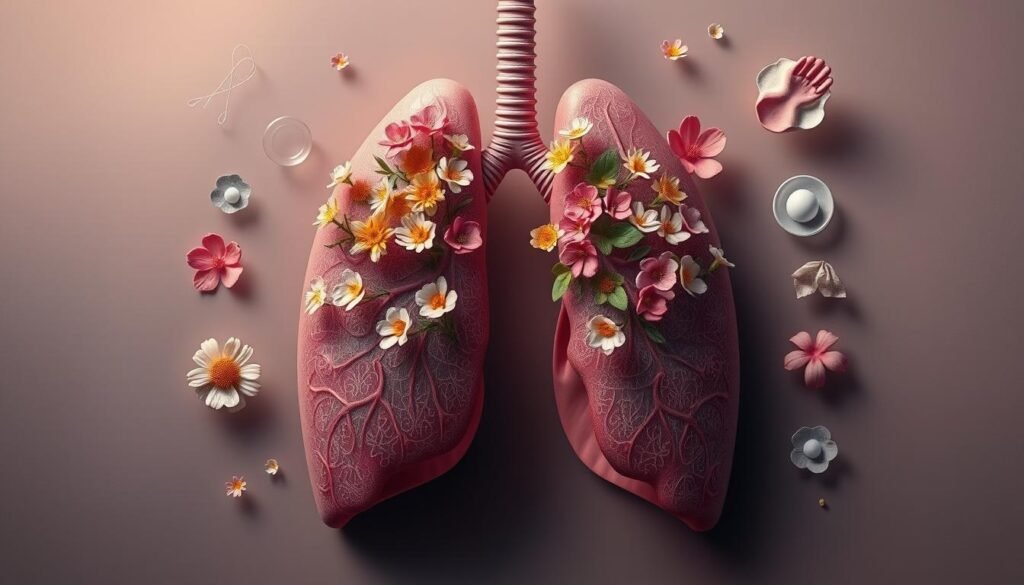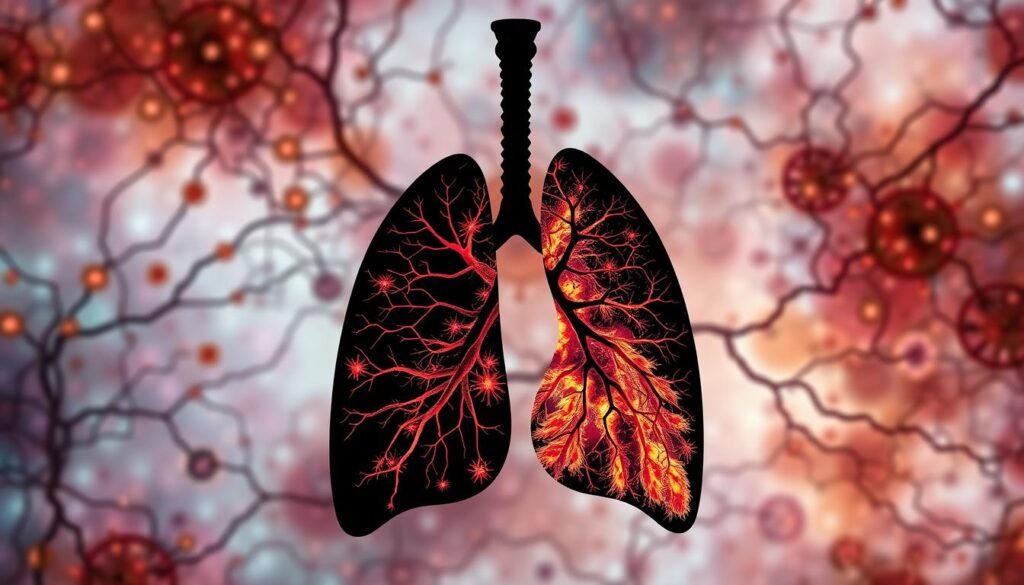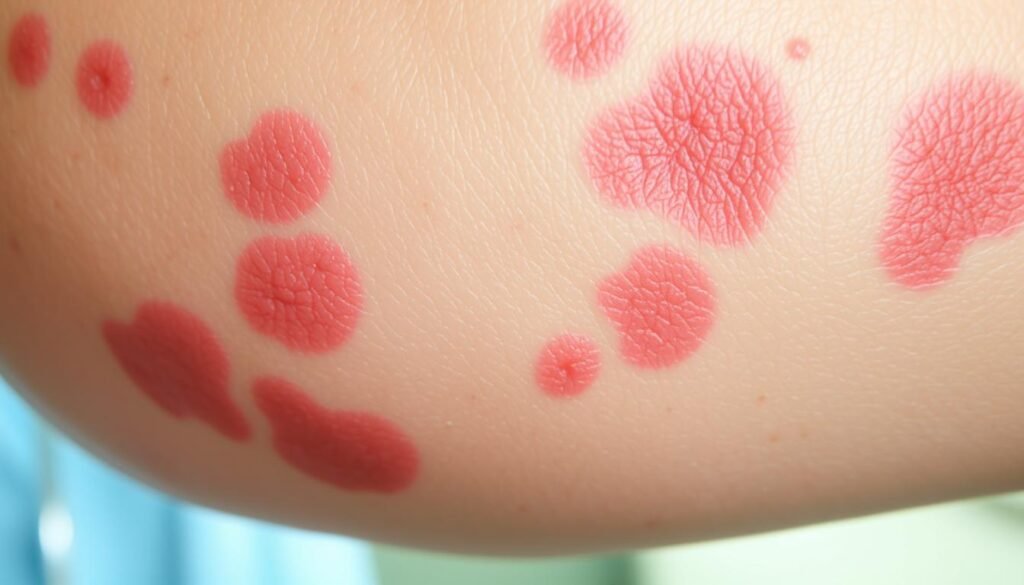Did you know about 10% of people treated with Opdivo (nivolumab) might get itchy skin? This shows the complex link between lung cancer and skin symptoms. It makes us wonder if lung cancer can lead to itchy skin. Though lung cancer mainly causes issues like coughing and trouble breathing, it can also lead to skin changes. Knowing about these signs is vital for both patients and doctors.
Skin symptoms might not be the first thing you think of with lung cancer. However, recent studies show how important they can be. As treatments go on or the disease gets worse, issues like itching, rashes, or skin spread may appear. These can be effects of the treatment or signs of the cancer getting worse. Spotting these lung cancer symptoms is key for good health management.
The link between itchy skin and lung cancer is about more than just feeling comfortable. It also might point to serious issues that need quick action. Next, we will explore more about what causes itchy skin, how lung cancer affects skin health, and what to watch out for.
Key Takeaways
- Itchy skin may arise as a side effect of lung cancer treatments.
- Approximately 10% of patients on Opdivo experience skin irritation.
- Skin changes can signal the progression or complications of lung cancer.
- Understanding the connection between lung cancer and skin symptoms can aid in patient care.
- Paraneoplastic syndromes may manifest as skin conditions related to lung cancer.
Understanding Lung Cancer
Lung cancer is a major health issue that demands wide awareness of its traits and effects. It mainly divides into two types: non-small cell lung cancer (NSCLC) and small cell lung cancer (SCLC). NSCLC makes up about 80 to 85 percent of cases, covering adenocarcinoma, squamous cell carcinoma, and large cell carcinoma. SCLC is rarer but comes in limited and extensive stages, depending on how far the tumor has spread.
Lung cancer starts in the lungs, leading to abnormal cell growth that might spread to other body parts. Often, symptoms like bone pain or jaundice don’t show until the late stages. Spotting early warning signs is key, since lung cancer diagnostics involve tests like CT scans and biopsies for quick identification.
Because lung cancer might not show symptoms early on, knowing the types of lung cancer and unusual signs is crucial. Look out for overall health changes, a lasting cough, or unexpected weight loss. Early detection and better treatment outcomes hinge on seeing a doctor when these signs appear.
The Connection Between Lung Cancer and Skin Symptoms
Learning how lung cancer and skin symptoms connect is important. Although rare, skin changes can happen with lung cancer. This can be because of cancer spreading or other conditions. People might see skin issues like rashes or feel itchy because of the disease or treatment reactions.
A study found half the adults with ongoing itching had a health issue. This suggests a strong link between skin problems and serious diseases. In fact, people with itchy skin are much more likely to have cancer than those without it. It shows how crucial skin signs are.
Cancer treatments can cause skin symptoms, including dryness and severe itching. Small red or purple bumps, called metastatic skin nodules, are serious signs of lung cancer. They signal the disease might be in an advanced stage. Recognizing these early is key to effective treatment.
Look out for warning signs like skin discoloration and hard nodules. Lung cancer might also cause red patches and blisters that don’t heal. Knowing these symptoms helps doctors start treatments sooner. This can lead to better results for lung cancer patients.
| Skin Symptoms | Description | Associated with Lung Cancer |
|---|---|---|
| Metastatic Nodules | Small, red or purple bumps on the skin. | Yes |
| Itching | Persistent itchiness without clear cause. | Yes |
| Discoloration | Changes in skin color or tone, leading to dullness. | Yes |
| Rashes | Various skin rashes appearing unexpectedly. | Yes |
| Flat Patches | Red, flat patches that do not heal. | Rarely |
Can Lung Cancer Cause Itchy Skin?
Itchy skin can be an unexpected symptom for lung cancer patients. This issue may come from the disease or treatments. A main cause of itchiness in lung cancer patients is jaundice. This happens when the skin or eyes turn yellow because of liver issues. It occurs when lung cancer spreads to the liver. Then, bile salts build up and cause more itching.
Conditions known as paraneoplastic syndromes significantly affect this too. For instance, Cushing’s syndrome, often seen with small cell lung cancer, leads to skin changes. These changes include bruising or stretch marks. Also, Pancoast tumors might trigger Horner syndrome. This results in facial flushing and abnormal sweating.
Sometimes, carcinoid syndrome causes flushing and itching. It is due to hormone overproduction by specific tumors. Moreover, when lung cancer causes superior vena cava syndrome, it can lead to flushing and other issues.
There are skin conditions linked with lung cancer, such as dermatomyositis. This condition might show signs like a heliotrope rash or Gottron papules. Furthermore, skin problems from treatments show a link too. For example, radiation can cause redness and targeted therapies might lead to rashes. These issues underline the possibility that lung cancer can cause itchy skin.
Common Symptoms of Lung Cancer
Lung cancer symptoms can greatly impact one’s health. Recognizing these signs early is key for fast action. Symptoms like persistent cough and chest pain are common and alert us to possible lung cancer.
Persistent Cough
A cough that lasts over three weeks is a clear warning sign. It might mean tumors are irritating the airways. If your cough gets worse or sounds different, pay attention.
Chest Pain
Chest pain is a serious symptom not to be overlooked. It might feel like pressure or inflammation from the lungs. This pain is a signal that something could be wrong.
Shortness of Breath
As lung cancer grows, breathing can become hard. This happens when fluid blocks airways, making the lungs work harder. If breathing gets tough, it’s time to see a doctor.
Unexplained Weight Loss
Many cancer patients face sudden weight loss. This might happen because of less appetite, the cancer’s energy demands, or how the body fights the illness. A drop in weight without trying needs checking out.

Knowing these signs can catch lung cancer early, improving treatment chances. For more on lung cancer symptoms, click here.
| Symptom | Description |
|---|---|
| Persistent Cough | A cough lasting more than three weeks that may worsen over time. |
| Chest Pain | Discomfort in the chest area, which can vary in severity and may indicate lung involvement. |
| Shortness of Breath | Difficulties in breathing that increase with activity or worsen over time. |
| Unexplained Weight Loss | Significant loss of weight without any known dietary changes or exercise efforts. |
Itchy Skin: A Potential Warning Sign
Itchy skin, known as pruritus, might mean you have cancer. While itchy skin causes like allergies or dry skin are common, itching without a clear reason might signal something serious. A study by Johns Hopkins in 2018 found that people who feel itchy all over could be more likely to have cancer.
Pruritus is linked with cancers like leukemia, lymphoma, and those affecting the bile duct and liver. Skin cancer can also make you itch. For example, Hodgkin’s lymphoma causes itching that gets worse with alcohol or at night.
When you itch, think about why it’s happening. Serious signs include:
- When the itching started
- Other symptoms like weight loss or jaundice
- Itching more after a shower or bath
Liver cancer might make your palms and soles itch a lot. Cancer treatments like chemotherapy can also make your skin dry and itchy. Some medications, including bortezomib and rituximab, have itching as a side effect.
If you have ongoing, unexplained itching, see a doctor. Catching the cause early can make a big difference in treatment.
Paraneoplastic Syndromes Related to Lung Cancer
Paraneoplastic syndromes are key to spotting lung cancer signs. These disorders stem from the immune system fighting cancer. Lung cancer is most often linked with these issues. About 20% of cancer patients might see these syndromes, showing up as skin problems.
Dermatomyositis
Dermatomyositis shows up as unique rashes and muscle weakness. It’s a big clue to hidden cancer. This condition makes the skin look like it has other issues but really points to lung cancer. People may suffer from itchy skin or rashes, highlighting the urgency of catching lung cancer early.
Cushing’s Syndrome
Cushing’s syndrome with lung cancer mainly comes from abnormal ACTH production, seen with small cell lung cancer. It leads to easy bruising and changes in skin texture. It’s crucial to know about this for quick action. Both patients and doctors must look out for these symptoms to ensure full exams are done.

Knowing about paraneoplastic syndromes like dermatomyositis and Cushing’s syndrome helps spot early symptoms. These often relate to skin issues. To learn about spotting lung cancer early, visit this resource.
Skin Changes from Lung Cancer Treatments
Lung cancer treatments often change the skin, reducing life quality for patients. Learning about these changes aids in managing lung cancer treatment side effects. This includes getting the needed support. Major treatments like radiation therapy and chemotherapy can lead to specific skin reactions.
Effects of Radiation Therapy
Radiation therapy may cause radiation burns and skin irritations. Patients frequently face:
- Redness in the treated area
- Dry skin and peeling
- Severe blistering in some cases
How severe these conditions are varies with skin type, which part of the body is treated, and how much radiation is used. Soft care and measures to protect the skin help lessen these effects.
Side Effects of Chemotherapy
Chemotherapy leads to various skin changes from chemotherapy that differ with each drug. Often seen effects are:
- Dry, itchy skin and darker skin areas
- More sun sensitivity
- Changes in nails, like cracking or getting yellow
Patient undergoing chemotherapy might experience hand-foot syndrome. It shows as redness and blisters on the palms and soles, which may affect walking or using hands.
Rashes from Targeted Therapy and Immunotherapy
Particularly, EGFR inhibitors in targeted therapies tend to cause rashes and itchiness. These rashes can cover large areas and look like other skin issues. Usual symptoms involve:
- Maculopapular rashes on different parts of the body
- Acneiform rashes, which are similar to acne
Telling your healthcare providers about any new skin conditions is crucial. This helps them find the right ways to manage them. For more on managing lung cancer treatment skin issues, check this guide.
| Treatment Type | Common Skin Effects | Management Tips |
|---|---|---|
| Radiation Therapy | Redness, dry peeling, blistering | Use gentle cleansers, avoid sun exposure |
| Chemotherapy | Dry skin, itching, nail changes | Moisturize regularly, protect from the sun |
| Immunotherapy | Rashes, acne-like bumps | Consult dermatology for severe issues |
Lung Cancer Skin Manifestations
Lung cancer can change the skin in many ways. These changes are signs of how far the disease has spread. Recognizing lung cancer skin manifestations helps spot and handle the disease early. Here, we mention some skin symptoms seen in lung cancer patients.
Skin Metastases
Skin metastases in lung cancer look like firm, painless bumps or sores. They appear on the chest, belly, head, or neck. This indicates that cancer from the lungs has spread to the skin. This shows the disease is in an advanced stage. Watching for skin metastases is crucial for understanding cancer’s spread.
Lesions and Nodules
As cancer grows, lesions and nodules can show up on the skin. These growths look different and might look harmless. But it’s vital for doctors and patients to tell them apart. They can show skin metastases in lung cancer, giving important clues about how the cancer is acting.
Flushing and Changes in Skin Color
Flushing and skin color changes can happen for many reasons in lung cancer patients. For example, Horner’s syndrome might make one side of the face flush and sweat less. Cushing’s syndrome may cause skin to bruise and show purple stretch marks. It’s important for patients seeing these changes to get checked out fully. They might point to a serious stage in the disease. Understanding these symptoms allows for better handling of lung cancer.

Other Causes of Itchy Skin
Itchy skin might seem scary, but it’s often not because of cancer. Many other conditions can make you itchy. Things like skin issues, allergies, and infections are usual suspects. They can bother you a lot without being a sign of something serious.
Common Non-Cancerous Causes
There are a bunch of reasons your skin might itch that aren’t cancer. Here are some:
- Eczema: This makes your skin dry, red, and itchy.
- Psoriasis: Your skin gets red and scaly because your immune system is in overdrive.
- Allergies: Eating certain foods or touching things can make you itchy.
- Dry skin: This happens a lot when it’s cold and makes you scratch.
- Hives: These are itchy bumps that show up after an allergic reaction.
- Skin infections: Fungus or bacteria can also make you itch.
Other Cancer Types Associated with Itching
Sometimes, cancer can make you itch. Here are some cancers that might do that:
| Cancer Type | Associated Symptoms |
|---|---|
| Leukemia | Itching comes from skin changes and body stuff. |
| Lymphoma | Itching can be part of the overall symptoms. |
| Myeloma | It might make you itch because of skin problems or infections. |
| Pancreatic Cancer | In late stages, you might start to itch. |
| Liver Cancer | Itching can happen when there’s too much bile salt. |
Telling the difference between itchy skin from cancer and other causes matters a lot. If you’ve had cancer before, or are worried, talk to a doctor. They can help you figure out why you’re itchy.
Conclusion
Knowing itchy skin and other signs of lung cancer is key for quick diagnosis and treatment. While itching is not always about lung cancer, it can point to big problems. This is true if it comes with symptoms like ongoing cough or weight loss you can’t explain. Skin changes in those with cancer are complex. They show how complicated the disease and its treatments are. This underlines why more research is needed.
If you’ve had itchy skin for a while, it might mean various things, such as allergies or skin issues. Sometimes, it could even mean cancer. Studies have shown that people with all-over itching might face a higher risk of getting skin cancer. This fact tells us how important it is to see a doctor if your skin keeps itching. Finding these symptoms early helps get good treatment started fast. This can make things better for people affected by cancer.
Working together across medical fields can make patient care better. Knowing how symptoms inside the body and on the skin are linked can improve treatments and life quality for cancer patients. So, watching any skin changes closely is crucial, especially considering the wide range of lung cancer symptoms. This is vital for the best health outcomes.